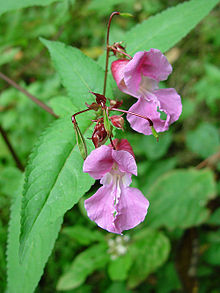Impatiens glandulifera: Difference between revisions
Beechhouse (talk | contribs) m Removed commercial links |
|||
| Line 34: | Line 34: | ||
== External links == |
== External links == |
||
*[http://www.jknotweed.com/himalayan-balsam-control Background and Control of Himalayan Balsam] |
|||
*[http://www.netregs.gov.uk/netregs/63105.aspx Identifying and removing Himalayan Balsam] on NetRegs.gov.uk |
*[http://www.netregs.gov.uk/netregs/63105.aspx Identifying and removing Himalayan Balsam] on NetRegs.gov.uk |
||
*[http://www.arkive.org/species/ARK/plants_and_algae/Impatiens_glandulifera/ Himalayan balsam (''Impatiens glandulifera'')] |
*[http://www.arkive.org/species/ARK/plants_and_algae/Impatiens_glandulifera/ Himalayan balsam (''Impatiens glandulifera'')] |
||
*[http://www.dgsgardening.btinternet.co.uk/himalbals.htm Himalayan Balsam recognition and eradication] |
|||
*[http://www.newtritionink.de/ Bionic Control of Himalayan Balsam] |
|||
*[http://www.ecocontrol.co.uk Eradication Strategies] |
|||
{{Commons|Impatiens glandulifera}} |
{{Commons|Impatiens glandulifera}} |
||
Revision as of 13:10, 21 July 2009
| Himalayan Balsam | |
|---|---|

| |
Secure
| |
| Scientific classification | |
| Kingdom: | |
| (unranked): | |
| (unranked): | |
| (unranked): | |
| Order: | |
| Family: | |
| Genus: | |
| Species: | I. glandulifera
|
| Binomial name | |
| Impatiens glandulifera | |
- "Policeman's helmet" redirects here. For the uniform headgear, see: Custodian helmet.
Himalayan Balsam (Impatiens glandulifera) is a large annual plant, native to the Himalaya (resulting in its the colloquial name of kiss-me-on-the-mountain[1] in the UK). It typically grows to 1 to 2 m high, with a soft green or red-tinged stem, and lanceolate leaves 5–23 cm long. The crushed foliage has a strong musty smell. The flowers are pink, with a hooded shape, 3–4 cm tall and 2 cm broad; the flower shape has been compared to a policeman's helmet, giving rise to the alternative common name Policeman's Helmet. Although it does not range all over India and is by no means the only Impatiens native to that country, it is also known as Indian Balsam in countries where it is introduced.

After flowering between June and October, the plant forms seed pods 2–3 cm long and 8 mm broad, which explode when disturbed, scattering the seeds up to 7 metres. Impatiens, meaning "impatient", refers to this method of dispersal. The green seed pods and seeds can be eaten, and also the young leaves and shoots, which is a method of controlling the plant's spread.[2]
Himalayan Balsam is sometimes cultivated for its flowers. It is now widely established in other parts of the world (such as the British Isles and the United States), in some cases becoming an invasive weed. The aggressive seed dispersal, coupled with high nectar production which attracts pollinaters, often allows the Himalayan Balsam to outcompete native plants. In the UK, some local wildlife trusts organise "balsam bashing" events to help control the plant.
However, a recent study (Hejda & Pyšek, 2006) concludes that in some circumstances, such efforts may cause more harm than good. Destroying riparian stands of Himalayan Balsam can open up the habitat for more aggressive invasive plants such as Japanese knotweed and aid in seed dispersal (by dropped seeds sticking to shoes). Riparian habitat is suboptimal for I. glandulifera, and spring or autumn flooding destroys seeds and plants. The research suggests that the optimal way to control the spread of riparian Himalayan Balsam is to decrease eutrophication, thereby permitting the better-adapted local vegetation that gets outgrown by the balsam on watercourses with high nutrient load to rebound naturally. Regarding stands of the plant at forest edges and meadow habitats, they caution that these conclusions do probably not hold true; in such localities, manual destruction is apparently still the best way to stem or slow the expansion of Himalayan Balsam.
The Bionic Control of Invasive Weeds in Wiesbaden, Germany is trying to establish a self sufficient project to conserve their local biodiversity by developing several food products made from the Impatient flowers. The final aim of these products is; that the Himalayan Balsam finances its own eradication.
References
External links
- Identifying and removing Himalayan Balsam on NetRegs.gov.uk
- Himalayan balsam (Impatiens glandulifera)
